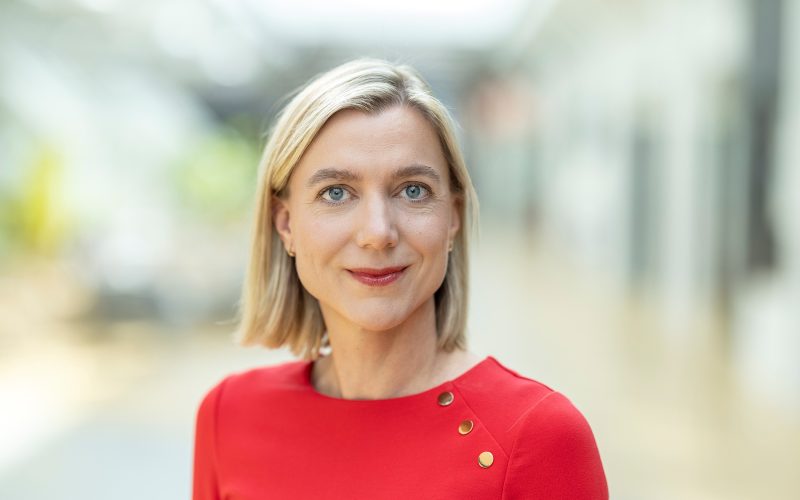On 31 October, Professor Linda van Laake delivered her inaugural lecture: Full speed ahead. This marks a milestone – for the first time in the Netherlands, a chair has been established within cardiology specifically focused on advanced heart failure. In her address, Van Laake advocates for greater awareness, earlier recognition, and innovative treatment of advanced heart failure. “These patients deserve new plans. To achieve that, we – as care providers and scientists – must move forward, full speed ahead.”
“On 9 February 1993, my uncle Frans suffered a major heart attack. He developed acute severe heart failure and died that same evening at the age of 43. Also in February 1993, Christa, then 36 years old, was the first person in the Netherlands to receive a Left Ventricular Assist Device (LVAD). This enabled her to survive for six months until a donor heart became available. Today, she is a proud grandmother and has lived for 32 years after her heart transplant. Two stories from the same period, with completely different outcomes. Frans and Christa had different plans, but heart failure turned their lives upside down.”
Heart failure is one of the fastest-growing health problems, yet many people don’t know what it is. “Only twenty percent of the Dutch population knows what heart failure means, while 250,000 to 500,000 people suffer from this chronic condition,” Van Laake explains. In heart failure, the heart pumps less effectively, depriving organs and muscles of oxygen and nutrients. In advanced heart failure, the pumping function is so severely impaired that even at rest the body is underserved. Medication is often no longer effective, but thanks to innovations such as LVAD or heart transplants, patients can live for many more years with a good quality of life.
In the Netherlands, advanced heart failure is often called “end-stage heart failure,” but this term is risky. “It implies that nothing more can be done, but not every patient with advanced heart failure is at the end. Internationally, advanced heart failure is recognized as an emerging field. We must adopt that awareness in the Netherlands, too. This new chair is a significant step in that direction. We’ve reached a turning point. With better recognition and innovative treatments, we can provide timely and appropriate care – and perhaps even prevent advanced heart failure.”
To ensure timely recognition, education is key – across the entire healthcare chain, from students and nurses to referring cardiologists and international colleagues. “We’ve developed a broad education program,” Van Laake explains. “We use tools like the I NEED HELP acronym, which helps care providers recognize early signs of advanced heart failure. In collaboration with colleagues from Nieuwegein and Antwerp, we’re also developing a smart algorithm that automatically identifies at-risk patients in the electronic health record. This is how we work together to ensure that each patient receives the right care and guidance on time.”
Although clinical research is already advanced, Van Laake believes it needs to be better – and faster. A key obstacle is the excessive bureaucracy. “Much of advanced heart failure care is based on experience, not hard evidence. But if we want to fairly compare two treatments, it currently costs hundreds of thousands of euros because of over-regulation – even if both treatments are already known and safe. That needs to change.” She calls on funders, care providers, and patient organizations to join the movement to reduce bureaucracy in research – so money and energy can go toward better care, not paperwork.
Many of Van Laake’s research projects focus on improving care through innovation. The UNRAVEL program collects data, blood, and tissue to understand underlying disease processes. Using the “heart in a dish” model, researchers grow heart muscle tissue derived from patients or stem cells, allowing them to test treatments like gene therapy directly. The Right Heart Failure project explores causes and treatments for right-sided heart failure through clinical and translational research. The Freezing Hearts project is developing techniques to freeze donor hearts without damage. “With all these innovative projects, we’re bringing science and care closer together – so our patients can enjoy more good years.”
Van Laake’s message is clear: advanced heart failure requires new plans – for patients, care providers, and researchers alike. “Through education and communication, we create more awareness so that every patient with advanced heart failure can receive the right treatment. More clinical research is needed to improve treatments, and to keep that affordable, we must reduce excessive regulation. New solutions to treat or prevent advanced heart failure will emerge from translational research, with contributions from scientists, clinicians, and a strong dose of curiosity. Together – full speed ahead!”
Read Christa’s full story (in Dutch) here – the first person in the Netherlands to receive a LVAD in 1993.
